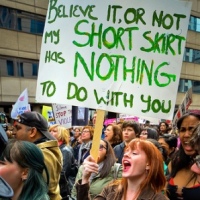CAUTION: IF YOU READ BIG PORN INC DON’T MAKE THE MISTAKE I DID AND TRUST THEIR SOURCES: eg ‘SPANKWIRE’ IS NOT GENITAL MUTILATION AS CLAIMED BY ROBI SONDEREGGER, BUT A WEBSITE
There’s a chapter in Big Porn Inc titled “Neurotica: Modern Day Sexual Repression” by Dr Robi Sonderegger, clinical psychologist, expert trauma consultant, and Chief Executive of Family Challenge Australia. The chapter includes a chart of online pornographic sub-genres which lists Google generated Webpages and total monthly searches (derived from Google Adwords) for 2010.
Top of the list is teen sex (actual post-pubescent adolescents) with 81,700,000 Web pages. Because the AdWords search is publicly restricted in this sub-genre, it isn’t possible to assess the number of monthly searches. However, Google Trends reports that juvenile sex terms were the most popular of all requests in 2010.
Second on the list is animal sex, with 50,300,00 Web pages and 6,120,000 monthly searches. Bondage, involving sadism and masochism has a total of 29.5 million pages with 5 million monthly hits.
Spankwire, a sexual practice involving the violent mutilation of reproductive organs comes in with 16,600,000 Web pages and 7,480,000 monthly searches.
Rape sex, involving real or portrayed forced unconsensual sex chalks up 2,770,000 Web pages and 550,000 monthly hits, while Snuff sex involving actual death of participants, consenting or otherwise, has a total of 1,280,000 Web pages and 6,600 monthly searches. There are no figures cited for the number of consenting participants who died during the production of snuff porn.
World population is currently around 7 billion, so some 0.1% of us are searching for violent mutilating porn on the internet, with slightly less searching for animal sex and bondage. Very few of us are seeking rape sex, rough sex and snuff sex, and there are only 480 searches a month for Guro sex, which involves blood, gore, disfiguration, mutilation, urine or feces.
There is no category in the chart that covers amateur porn, a genre that is apparently the most accessed in Australia and does not involve extreme acts. Neither is this genre mentioned anywhere at all in the book as being by far the most accessed in this country.
One of the claims made by some contributors to Big Porn Inc is that we are witnessing an unprecedented explosion in the production of pornography that is seriously interfering with the ability of many human beings to conduct satisfactory sex lives with actual partners, as well as involving more people than ever before in its allegedly damaging production.
Unfortunately, it’s difficult to prove these claims as we have little historical statistical data with which to compare current trends. There are many more people in the world and there are a vast array of technologies available that allow production and distribution to a degree previously unheard of. But does this necessarily mean a larger percentage of us are involved as producers and consumers? Is there really a new epidemic of porn, or has what was previously covert become highly visible?
While the Big Porn contributors assume that porn consumption damages and even destroys the ability to enjoy actual sex, I would suggest that in situations where this appears to be the case it’s worth considering that sexual and/or relationship difficulties already exist, and porn is a symptom rather than a cause.
This needs to be more fully researched before it can be definitively claimed that porn causes sexual dysfunction.The confusion of symptoms with cause is a common one in discussions of addiction, whether we’re talking about drugs, alcohol, gambling or pornography. Addictions are usually a destructive form of self-medication and self-soothing that bring relief from emotional tension with the temporary pleasures they offer. Pornography can offer this relief to those who are seeking it. However, porn is also a subject of curiousity and pleasure for some consumers and has nothing to do with addictive behaviour.
That human beings have a dark side is not news. I doubt there is one sexual practice in Dr Sonderegger’s chart that hasn’t been around throughout our history, albeit in less technologically sophisticated modes. With the advent of the internet, dissemination of images has become globally simple, granting unprecedented access to consumers and making voyeurism more possible than ever before.
However, if there is a larger percentage of us emerging as chronically sexually disturbed as a consequence of this availability, it is difficult to determine. The fact that people are more likely to admit to sexual dysfunction (and to the use of pornography) than say, thirty years ago, does not mean there is necessarily a higher percentage of us in either category than there used to be.
There’s a chapter in Big Porn Inc titled “Sexting and Peer-to-Peer Porn” by Nina Funnell, in which the role of children as “active producers of pornography” is discussed. Unfortunately, some of the examples the author offers of the disastrous effects of sexting and peer-to-peer porn concern 18-year-old women, thus creating a confusing conflation of children and adults. The two are entirely separate categories and should be investigated as such.
Funnell goes on to discuss the theft and publication of private video tapes of adult “celebrities” such as Pamela Anderson and Paris Hilton having sex, (not with each other, I hasten to add in case I’m sued) under the heading “Captured girls in popular culture.” Neither woman can be described as a “girl.” This conflation of children and adult women is a common one in anti pornography literature, and as well as being offensive and un-rigorous, serves to undermine the credibility of activists’ claims.
In the US medical journal of Pediatrics on December 5 2011, there’s an article revealing research that shows the panic about children sexting is unwarranted. The survey is one of the largest ever to investigate the prevalence of sexting among minors, and researchers have concluded from their results that previous reports claiming large numbers of children are sending texts that could be viewed as pornographic are overblown. One of the researchers observed: “This [children’s sexting] has been reported as if it were something that everyone was doing, not just in the teen population, but in the young adult population. It’s really not the case.”
In previous studies into minors sexting, young adults aged 18 and 19 were included as “children.” In a bizarre way, anti pornographers are guilty of committing a similar offense as that of which they accuse pornographers, albeit for different reasons: they both blur the boundaries of childhood and adulthood to achieve their desired outcomes.
I am offended by the judgement prevalent in the book that any one who does not uncritically accept anti porn activist rhetoric is supportive of the exploitation and harming of women and children. Activist Catharine MacKinnon goes so far as to suggest that women who do not support her claims (“academic women who breathlessly defend pornography…”) do so solely in order to curry favour with men. The charge is also made that those who oppose the activists’ positions are seeking the thrill of unconventionality, and to present themselves as sexier than the anti porn collective. It is notable than disagreement with the activists’ point of view is met by them with ad hominem responses rather than considered debate.
It has never been my habit to uncritically accept any rhetoric, and I see no reason to abandon that rigour under pressure from bullies who describe me as having a prick in my head if I disagree with some of their opinions. I am no more in favour of human beings being damaged for the gratification of other human beings than are activists such as MacKinnon, Dines, Bray and Tankard Reist. Their condemnatory judgment of women who do not wholly agree with them is an indicator of their emotional immaturity, as they attack like adolescents in a playground gang.
For example, in a chapter by Helen Pringle titled : A Studied Indifference to Harm: Defending Pornography in The Porn Report” the author conducts a sustained and personal attack on academics Alan McKee, Catharine Lumby and Katherine Albury who in 2008 published the first piece of serious research on the state of pornography in Australia. In a scathing final paragraph, Pringle states: “Like many academic defenses of pornography, The Porn Report delights in its supposed unconventionality. In fact, its arguments are tired and outdated…The fact that pornography users are, like McKee himself. “intellectually competent individuals”…does not excuse the project’s studied indifference to the harm enacted in and by the sexual subordination and cruelty that defines modern pornography.”
I would argue that in certain pornographic genres ” sexual subordination and cruelty” have always been a mainstay, and there’s nothing “modern” about that at all. Perhaps Ms Pringle is unaware of anything earlier than the 1980’s, as she also mocks the authors’ references to sexual repression in the 50’s and 60’s. It would seem to me that a historical perspective on pornography is both useful and interesting. However, such a perspective may cause a re-evaluation of claims of a current apocalyptic epidemic.
Big Porn Inc is not a pleasant read, as much for the way in which the majority of the book is written, as well as disturbing explicit content. As I forged my way through it, I repeatedly asked myself, who has this book been written for? What is it’s imagined readership?
The last articles in the book consist of descriptions of various organisations set up to combat the production and distribution of porn, listed in a section titled “Resisting Big Porn Inc.” Included is the “Quit Porn Manifesto” written by the book’s publisher, Susan Hawthorne of Spinifex Press. Hawthorne likens the consumption of pornography to smoking in its insidious effects on users. She then offers some basic strategies designed to help a user quit porn, and asks: “Who do you support? The profiteers and purveyors of violence? Or those harmed by pornography? Porn is bad for you. It’s time to quit porn.”
There are no grey areas in the world views expressed in this collection. All porn is very, very bad. This is not a position with which I am in agreement. It is a totalitarian position, and for that reason alone, the reader should be extremely wary, while at the same time taking from the collection some of the thought-provoking information it also contains. Unlike the authors, readers need not throw out the baby with the bath water.
Big Porn Inc. Melinda Tankard Reist, Abigail Bray (eds) 2011. Spinifex Press, Melbourne.
Related articles
- Dangerous or a rite of passage (smh.com.au)a





































Recent Comments